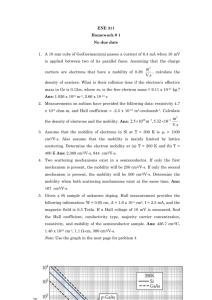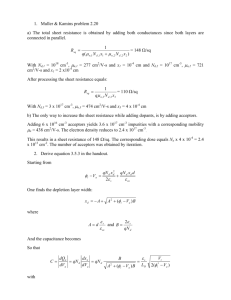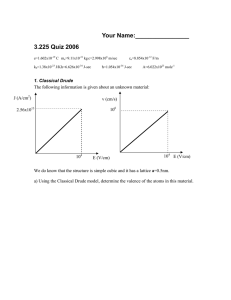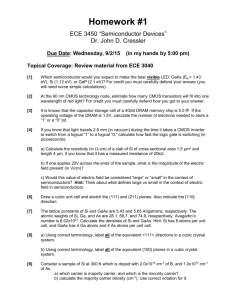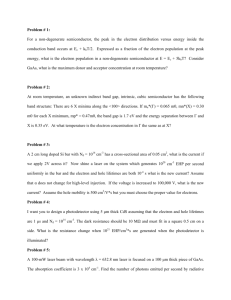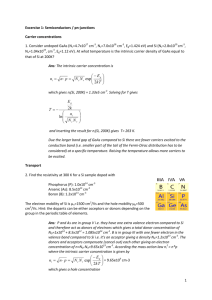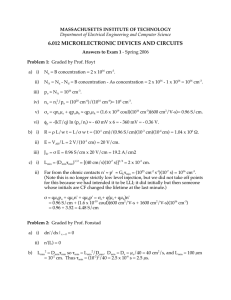Document 13578685
advertisement
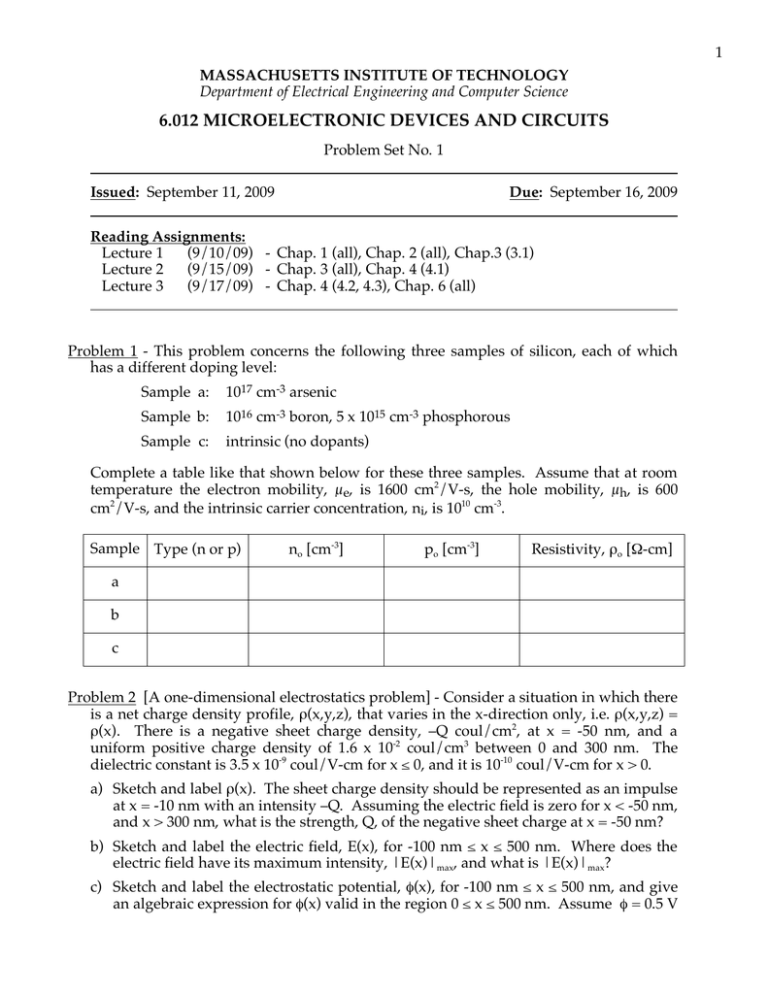
1 MASSACHUSETTS INSTITUTE OF TECHNOLOGY Department of Electrical Engineering and Computer Science 6.012 MICROELECTRONIC DEVICES AND CIRCUITS Problem Set No. 1 Issued: September 11, 2009 Due: September 16, 2009 Reading Assignments: Lecture 1 (9/10/09) - Chap. 1 (all), Chap. 2 (all), Chap.3 (3.1) Lecture 2 (9/15/09) - Chap. 3 (all), Chap. 4 (4.1) Lecture 3 (9/17/09) - Chap. 4 (4.2, 4.3), Chap. 6 (all) Problem 1 - This problem concerns the following three samples of silicon, each of which has a different doping level: Sample a: 1017 cm-3 arsenic Sample b: 1016 cm-3 boron, 5 x 1015 cm-3 phosphorous Sample c: intrinsic (no dopants) Complete a table like that shown below for these three samples. Assume that at room temperature the electron mobility, µe, is 1600 cm2/V-s, the hole mobility, µh, is 600 cm2/V-s, and the intrinsic carrier concentration, ni, is 1010 cm-3. Sample Type (n or p) no [cm-3] po [cm-3] Resistivity, ρo [Ω-cm] a b c Problem 2 [A one-dimensional electrostatics problem] - Consider a situation in which there is a net charge density profile, ρ(x,y,z), that varies in the x-direction only, i.e. ρ(x,y,z) = ρ(x). There is a negative sheet charge density, –Q coul/cm2, at x = -50 nm, and a uniform positive charge density of 1.6 x 10-2 coul/cm3 between 0 and 300 nm. The dielectric constant is 3.5 x 10-9 coul/V-cm for x ≤ 0, and it is 10-10 coul/V-cm for x > 0. a) Sketch and label ρ(x). The sheet charge density should be represented as an impulse at x = -10 nm with an intensity –Q. Assuming the electric field is zero for x < -50 nm, and x > 300 nm, what is the strength, Q, of the negative sheet charge at x = -50 nm? b) Sketch and label the electric field, E(x), for -100 nm ≤ x ≤ 500 nm. Where does the electric field have its maximum intensity, |E(x)|max, and what is |E(x)|max? c) Sketch and label the electrostatic potential, φ(x), for -100 nm ≤ x ≤ 500 nm, and give an algebraic expression for φ(x) valid in the region 0 ≤ x ≤ 500 nm. Assume φ = 0.5 V 2 at x = 500 nm. What is the change in potential, Δφ, between x = -100 nm and x = 500 nm? d) Finally consider how ρ(x), E(x), and φ(x) change if the extent of the uniform charge density is reduced and it now only extends from x = 0 to x = 200 nm. i) Is Q larger or smaller, and by how much? ii) Is |E(x)|max larger or smaller, and by how much? iii) Is Δφ larger or smaller? Problem 3 - A p-type sample of silicon has a resistivity of 5 Ω-cm. In this sample, the hole mobility, µh, is 600 cm2/V-s and the electron mobility, µe, is 1600 cm2/V-s. Ohmic contacts are formed on the ends of the sample and a uniform electric field is imposed which results in a drift current density in the sample is 2 x 103 A/cm2. a) What are the hole and electron concentrations in this sample? b) What are the hole and electron drift velocities under these conditions? c) What is the magnitude of the electric field? Problem 4 - This problem concerns a sample of Semiconductor X. At room temperature in Semiconductor X, the intrinsic carrier concentration, ni, is 107 cm-3, the hole mobility, µh, is 300 cm2/V-s, and the electron mobility, µe, is 4000 cm2/V-s. The minority carrier lifetime, τmin, is 10-9 s. This sample is known to have 2 x 1016 cm-3 donors and an unknown number of acceptors. A measurement is made on the sample and it is found to be p-type with an equilibrium hole concentration, po, of 5 x 1017 cm-3. a) What is the net acceptor concentration, NA (= Na - Nd), in this sample, and what is the total acceptor concentration, Na? b) What is the equilibrium electron concentration, no, in this sample at room temperature? c) What is the electrical conductivity, σo, of this sample in thermal equilibrium at room temperature? d) This sample is illuminated by a steady state light which generates hole-electron pairs uniformly throughout its bulk, and the conductivity of the sample is found to increase by 1% (that is, to 1.01 σo). What are the excess hole and electron concentrations, p' and n', in the illuminated sample, assuming that the illumination has been on for a long time? f) What is the optical generation rate, GL, in Part d? g) If the illumination in Part d is extinguished at t = 0, write an expression for the sample conductivity as a function of time for t > 0. Express your answer in terms of σo, rather than the numerical value. MIT OpenCourseWare http://ocw.mit.edu 6.012 Microelectronic Devices and Circuits Fall 2009 For information about citing these materials or our Terms of Use, visit: http://ocw.mit.edu/terms.

